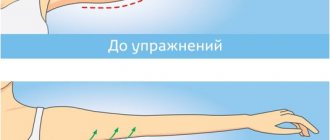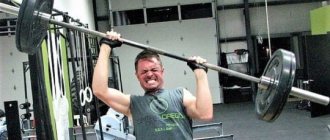HIIT (High-intensity interval training) or HIIT is an effective scientifically proven method of training, which is many times greater than long-term strength and cardio exercises. Although not everyone knows about it yet, most have already heard about CrossFit and Tabata, which can also be classified as the HIIT method. The training methods are slightly different, but there is a lot in common, the most important thing is high results with little time spent.
What is HIIT and how does the training work?
High-intensity interval training (HIIT) involves alternating short, intense periods with less intense periods for recovery. There is an alternation of, for example, twenty-second periods with maximum output (about 80-95% of maximum heart rate) and sixty second periods with lower intensity (about 50-40% of heart rate).
Typically such loads do not exceed 30 minutes. The duration of the periods may vary, the recovery period may be equal to the intensive period, or slightly exceed it.
As an illustrative example, consider training on a treadmill.
After a warm-up - walking for 5-7 minutes, a high-intensity period begins - running at maximum speed for 20 seconds, then the speed decreases to walking for one minute. And so on for 10-15 minutes.
The main difference between HIIT and long-term cardio in the fat burning mode is several times higher rates: increased speed, strength, power and accelerated fat burning.
What are HIIT workouts for?
- Firstly, such training will help in sprinting and sports where it is necessary to increase indicators such as strength and speed.
- Secondly, such training is necessary for fitness enthusiasts who have reached a “plateau” in their training.
- Thirdly, such training helps speed up the process of losing weight.
- And also the growth of muscle mass thanks to the anaerobic regime.
Research has repeatedly proven the effectiveness of HIIT. It was found that with short, high-intensity training, anabolic performance increases, without the destruction of muscle fibers, as with long-term cardio and marathons. Short workouts can preserve muscle while burning fat long after the workout is completed.
What is HIIT training?
HIIT (HIIT - high-intensity interval training) is a method that involves alternating short intense training phases and less strenuous, restorative periods of physical activity.
To understand the essence of HIIT, just remember what marathon runners and sprinters look like. The first ones are hardy, but they are not examples to follow in terms of design. The bodies of the latter are not designed for long distances, but reflect the goals of most gym-goers of the stronger sex.
The essence of the training
An example of HIIT is a combination of 15 second sprints with 45 seconds of slow walking (or even resting) for 10-15 minutes. During high-intensity periods, unlike light phases, the body is fueled with energy from carbohydrates, not from fats. The HIIT strategy is used in two main variants - cardio (aerobic) and strength (anaerobic).
Regular cardio training takes place at a moderate intensity, in which the heart rate (HR) is 60-70% of the maximum. Such classes can last from 30-40 minutes or longer. Aerobic training burns fat directly during training.
High-intensity interval training (HIIT) uses different principles. The minimum heart rate in the heavy phase is 80% of the limit. The upper limit is 95%. The magnitude of the load is determined both by sensations and by calculations. Depending on your heart rate and type of activity, intense phases can last from 5 seconds to a couple of minutes. Highly active sessions are followed by recovery periods, the duration of which can be equal or longer (in rare cases, even shorter for experienced athletes).
During the recovery period, physical work takes place at 40-60% of the maximum heart rate. The duration of a HIIT workout is from 4 minutes to an hour. Most often, such training takes 15-30 minutes. Even very busy people can practice in this format, quite rightly expecting a noticeable result.
The main difference between HIIT training and aerobic exercise is the type of calorie expenditure. Low-intensity cardio allows you to burn fat while you're doing it. With HIIT, most of your calories are burned after your workout. At the same time, it takes significantly less time to obtain a similar result.
Scientific background
HIIT training – what is it from a scientific point of view? HIIT triggers the effect of intense oxygen absorption, which requires active fat burning. And this happens mostly during the recovery period. The effect is called EPOC.
Short sessions do not require energy overexpenditure, but post-workout processes lead to the burning of additional calories. The body begins to use glycogen reserves differently. Metabolism changes at a fundamental level.
Many fans of physical activity are accustomed to believing that the most effective way to get rid of fat accumulation is low-intensity aerobic training. But numerous studies convince us of the benefits of HIIT.
Examples:
- The convincing advantage of HIIT over aerobic training was demonstrated by Canadians back in 1994. One group of “test subjects” trained for 20 weeks in a classic cardiostyle. The second one practiced HIIT for 15 weeks. As a result, the aerobic group burned 15,000 more calories during exercise than the HIIT athletes. But the final fat loss was greater in the second group.
- At the beginning of the 2000s, Australians selected 2 groups of women. The first group trained at an intensity of 60% of maximum heart rate for 40 minutes. The second alternated 8-second sprints with 12 seconds of rest for 20 minutes. Despite taking half the time, the women who did the high-intensity workout lost 6 times more fat.
HIIT interval training triggers metabolic changes in the body, which affects the mechanism of fat oxidation. The latter burn much faster. In addition, high-intensity training increases testosterone production (there are a number of studies on this topic). Hence the external difference between marathon runners and sprinters - testosterone has a positive effect on increasing and maintaining muscle mass (the second is especially important when losing weight in a calorie deficit).
© bnenin — stock.adobe.com
The benefits and harms of HIIT training
Why HIIT is useful:
- Increases endurance, while at the same time increasing muscle mass.
- Reduces the percentage of body fat without compromising muscle mass.
- The body uses glycogen for fuel, and HIIT helps improve insulin sensitivity, which increases the use of carbohydrates for energy. This way, fewer carbohydrates will be absorbed as fat.
- Normalizes blood pressure and strengthens the heart muscle, provided that the athlete does not have cardiovascular diseases.
- Normalizes blood cholesterol levels.
Harm and disadvantages of HIIT:
- Training is prohibited for any diseases of the cardiorespiratory system, hypertension, diabetes, coronary heart disease.
- It is not recommended to train for people who have bad habits - smoking, alcohol, as there is a risk of developing heart ischemia.
- With illiterate and long-term HIIT, there is a risk of deterioration of the heart condition, so it is important to correctly distribute the load and recover sufficiently.
- You should not exceed the number of workouts more than three times a week.
- Since training has contraindications and is dangerous for some people, you should consult a doctor before starting .
What is interval training and why does it help you lose weight?
The modern standard of fitness training, which allows you to train three times a week for only 4 minutes, is called high-intensity interval training (HIIT), or HIIT - High Intensity Interval Training. In our country, they are known as circuit training for burning fat for women and men.
High-intensity interval training, or circuit training, was first studied at a university in Canada.
Physiologist Martin Gibala, who conducted the research, found that ITVI performed for three minutes on an exercise bike is similar in its beneficial effects on muscles to regular cycling for 1.5-2 hours.
Further, Dr. Gibala was able to establish that high-intensity interval training is significantly more beneficial for weight loss than regular aerobic exercise.
During this study, volunteers were divided into two groups. The first group performed regular long-term aerobic exercise for 20 weeks. The second is ITVI 15 weeks.
As a result, it was found that the first group burned 48% more calories per workout than the second group. But! After 15 weeks of exercise, participants in the ITVI group lost 900% more fat than volunteers in the normal exercise group for 20 weeks.
Comparative graph of weight loss intensity during regular fitness and ITVI
Since then, not a single study has been conducted to prove that high-intensity interval training can completely replace longer and more mentally tiring regular exercise.
The HIIT method cannot be called simple and easy, since it requires a person to mobilize all his physical resources. People in poor health should not attempt high-intensity interval training without prior evaluation. But this approach has a very important advantage - it does not require much time, it is easier to implement purely psychologically.
After all, very often people give up fitness because they simply do not have the mental strength to exercise often and for a long time. This is usually called lack of time. Although the point, of course, is not about time as such. You can always find him. There would be a desire.
It’s just that regular workouts are so mentally tiring due to their duration that most people simply cannot withstand such stress. The HIIT method makes it possible to train for just 12 minutes per week, while receiving the same benefits as regular long-term aerobic training.
High intensity interval training (HIIT), or HIIT - High Intensity Interval Training, can be done on any type of cardio equipment: on treadmills or exercise bikes. However, the best option is an elliptical trainer, which allows you to use the most number of muscles during training, and, therefore, perform physical work at the most active level.
How to train HIIT style
Before starting the load, you should adequately assess your own capabilities.
Remember, HIIT is a serious thing that can be both beneficial and harmful.
Therefore, stock up on a heart rate monitor, which will become your constant companion, and most importantly, will protect you from overtraining and keep your heart healthy. Another important advantage of a heart rate monitor is the accurate calculation of heart rate, which must be constantly monitored in order to increase the effectiveness of exercise. Unfortunately, you can’t track your pulse so often on your own, so buy a chest heart rate monitor - this is important!
Now you need to calculate your own heart rate zones for HIIT, this can be done using the formulas:
((Maximum heart rate - resting pulse) × intensity in %) + resting pulse;
Maximum heart rate is calculated using the formula: 220 – age.
For example , let’s take a 30-year-old man with a resting heart rate of 60 beats/min.
220 - 30 = 190 (maximum heart rate).
So, let’s calculate individual HIIT heart rate zones:
- ((190 - 60) x 80%) + 60 = 164 (maximum heart rate with HIIT) .
- ((190 - 60) x 40%) + 60 = 112 (minimum heart rate during the recovery period) .
Thus, during the intensive period, the pulse should not exceed 164 beats per minute, and during the recovery period not lower than 112 beats per minute.
For more prepared athletes, the calculation can be based on figures of 90-95% for the intensive period, and 50% for recovery.
So, we decided on the pulse. Next, you need to properly organize the training process.
- For HIIT cardio, such as on a treadmill, you need to warm up with 5 to 7 minutes of brisk walking.
- Training periods can be adjusted independently. For beginners, the best option would be this scheme: 30 seconds of running and 60 seconds of recovery.
For such a workout, 10 minutes is enough.
For more advanced athletes, HIIT can be done as follows: 30 seconds run, 30 seconds recovery. After training, you need to lower your heart rate by walking for 7-10 minutes. At the end of the cardio, you should stretch all the muscles.
Read more about post-workout stretching →
Cardio HIIT workout program
In addition to the complexes given below, you can create a training program yourself, you need to change the exercises, the duration of the periods, but most importantly, take into account physical indicators, health and be sure to calculate the pulse zones .
HIIT training in video format
List of exercises for cardio HIIT
- Burpee.
- Jump rope.
- Running in place, plank, sprint.
- Any cardio equipment.
- Jumps and variations of jumps.
- Squats and jumping ups.
In fact, the list does not end with these exercises; there is a huge variety of them, so developing a workout will not be difficult.
Low load level
Complex No. 1
Perform 3 circles of 5 exercises according to the following scheme: 40 seconds of load, 40 seconds of recovery. Do the exercises one at a time. The workout will take 20 minutes.
- Burpee.
- Jumping rope.
- Running with knees raised.
- Aerial lunges.
- Plank running.
Complex No. 2
Perform five exercises in 4 circles at intervals: 30 seconds of intense period, 30 seconds of recovery. The workout will take 20 minutes.
- Jumpin Jacks.
- Jump squats.
- Plank jumps.
- Plank running.
- Jumping to higher ground.
Advanced level
Three rounds of five exercises, in each round perform an intense load for 60 seconds and recover for 30 seconds. The workout lasts 22 minutes.
- Burpee.
- Jump squats.
- Aerial lunges.
- Plank jumps.
- Jumping rope.
What is the workout made from? Program!
A workout for beginners could be like this:
1. Squats, you can start without weights. 8 reps.
2. Lunges forward with turns to change the supporting leg, you can start without weights. 8 reps.
3. Difficult push-ups (optional) - 4 repetitions, regular push-ups - 4 repetitions.
4. Classic crunches, you can start without weights. 8 reps.
The entire complex must be performed four times without rest between approaches.
There’s no point in staying too long at a workout for beginners—there’s too much interesting stuff ahead. For example, this workout ( training for the prepared ):
1. Push-ups with your feet up (for example, place them on a chair).
2. Squat jumps (remember to keep your body weight on your heels).
3. Side crunches with rolls (alternate sides, rolling to the other side).
4. Squats with weights - push-ups - jump up with weights.
Each exercise is 1 minute. Perform 3 circles without rest.
Or this:
1. Running with high knees (10 times) - lie on your stomach - stand up. 6 reps.
2. Jumping with your feet to the sides in a plank. 25 times.
3. Lifting the pelvis while lying on your back (without jerking or rocking, press your lower back to the floor). 20 reps.
4. Jump onto a stool (one leg always stands on a stool). 20-25 repetitions on each leg.
5. “Superman” push-ups (with opposite legs and arms raised in the upper position). 6-10 repetitions.
Perform this complex 4 times without rest.
Whatever you want, I’ll try! And let's share our impressions.
HIIT Strength Training Program
Strength training differs from HIIT cardio in that strength exercises are performed with a weight that is suitable for a maximum of 5-8 repetitions. Each exercise is performed one after another without a pause, but at the end of the circle you need to recover for 2-3 minutes. Do not perform more than 4 laps. The optimal duration of such a workout is 15 minutes.
An example of a strength complex for those who are trained:
- Sumo squats – 5-8.
- Lunges alternately forward – 8.
- Good morning – 5-8.
- Thrusters – 5-8.
- Deadlift – 5-8.
- Barbell row to the belt – 5-8.
As for strength training, the list of exercises here is also quite diverse. To begin with, it is important to warm up the ligaments, muscles and joints well. The weight of the load must be added gradually as the complex is completed. It is important to do the exercises quickly, but not to lose quality.










